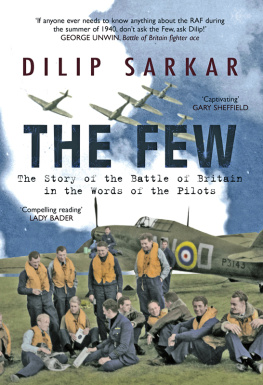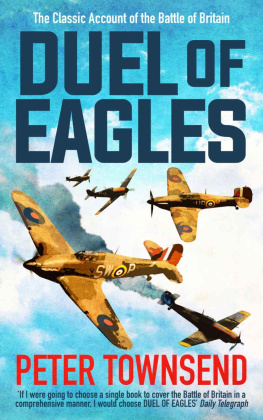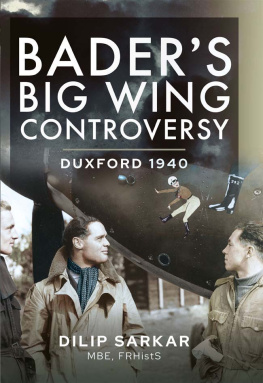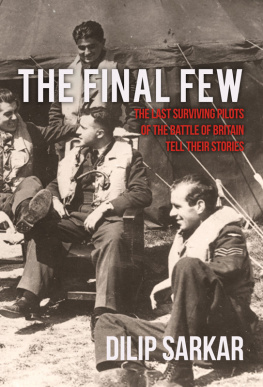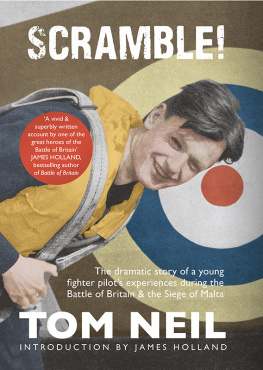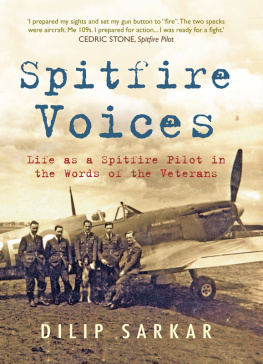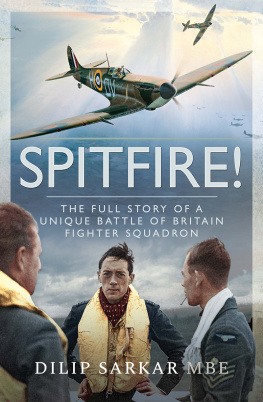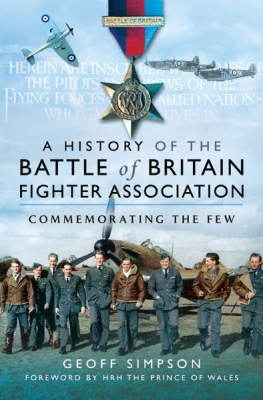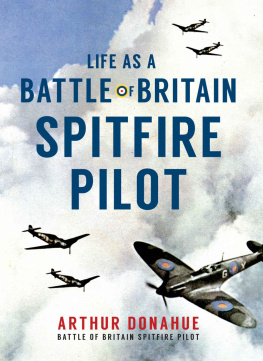THE FEW
THE BATTLE OF BRITAIN started on 10 July 1940, ending 16 weeks later on 31 October 1940. The Luftwaffes intention was to destroy Fighter Command, domination of the skies being crucial to Hitlers invasion plan. During that fateful summer, young RAF fighter pilots, flying Spitfires and Hurricanes, were scrambled time and time again to face insuperable odds and the Luftwaffe was, until that point, unbeaten. The enemy fighter pilots, in their brightly painted Messerschmitt 109s, were the most experienced in the world. But somehow the RAF pilots, fighting desperately in a spiders web of intricate vapour trails, and with sudden and violent death an ever present companion, prevailed. Afterwards, Churchill paid homage to them all: Never in the field of human conflict has so much been owed by so many to so few. A legend had been born.
Dilip Sarkar has been fascinated by the Battle of Britain since childhood and began seriously researching the subject in the 1970s. He wrote thousands of letters and travelled extensively over the UK interviewing the fabled Few. Over the last 30 years he has interviewed more Battle of Britain survivors than any other author and his archive is a unique collection of veterans voices. In this new book Dilip Sarkar chronicles the Battle of Britain from start to finish drawing extensively from his interviews with pilots.
ABOUT THE AUTHOR
DILIP SARKAR has written over twenty books on the Battle of Britain, including the only biographical works formally endorsed by the families of both Group Captain Sir Douglas Bader and Air Vice-Marshal Johnnie Johnson. In 2003, Dilip was made an MBE for services to aviation history, and in 2006 he was elected to the Fellowship of the Royal Historical Society. He lives in Worcester.
THE FEW
The Story of the Battle of Britain
in the Words of the Pilots
DILIP SARKAR
MBE FRHistS
AMBERLEY
For my wife, Karen
First published 2010, this edition 2012
Amberley Publishing
The Hill, Stroud
Gloucestershire GL5 4EP
www.amberley-books.com
Copyright text and all photographs Dilip Sarkar, 2009, 2010
The right of Dilip Sarkar to be identified as the Author of this work has been asserted in accordance with the Copyrights, Designs and Patents Act 1988.
All rights reserved. No part of this book may be reprinted or reproduced or utilised in any form or by any electronic, mechanical or other means, now known or hereafter invented, including photocopying and recording, or in any information storage or retrieval system, without the permission in writing from the Publishers.
British Library Cataloguing in Publication Data.
A catalogue record for this book is available from the British Library.
ISBN 978-1-4456-0050-5 (PRINT)
ISBN 978-1-4456-0986-7 (e-BOOK)
CONTENTS
ALSO BY DILIP SARKAR
Spitfire Squadron: No 19 Squadron at War, 193941
The Invisible Thread: A Spitfires Tale
Through Peril to the Stars: RAF Fighter Pilots Who Failed to Return, 193945
Angriff Westland: Three Battle of Britain Air Raids Through the Looking Glass
A Few of the Many: Air War 193945, A Kaleidoscope of Memories
Baders Tangmere Spitfires: The Untold Story, 1941
Baders Duxford Fighters: The Big Wing Controversy
Missing in Action: Resting in Peace?
Guards VC: Blitzkrieg 1940
Battle of Britain: The Photographic Kaleidoscope, Volume I
Battle of Britain: The Photographic Kaleidoscope, Volume II
Battle of Britain: The Photographic Kaleidoscope, Volume III
Battle of Britain: The Photographic Kaleidoscope, Volume IV
Fighter Pilot: The Photographic Kaleidoscope
Group Captain Sir Douglas Bader: An Inspiration in Photographs
Johnnie Johnson: Spitfire Top Gun, Part I
Johnnie Johnson: Spitfire Top Gun, Part II
Battle of Britain: Last Look Back
Spitfire! Courage & Sacrifice
Spitfire Voices
The Battle of Powick Bridge: Ambush a Fore-thought
Duxford 1940: A Battle of Britain Base at War
Hearts of Oak: The Human Tragedy of HMS Royal Oak
Last of the Few
Spitfire! The Experiences of a Battle of Britain Fighter Pilot (as editor)
FOREWORD BY LADY BADER
I have known Dilip Sarkar for many years now, his diligent and tenacious research into the flying career of my late husband, Group Captain Sir Douglas Bader, and his pilots enormously and immediately impressed me. The Battle of Britain story, I know, Dilip finds greatly inspirational, and over the last thirty years he has sought out and interviewed or corresponded with numerous survivors worldwide. Many of these were not famous combatants like Douglas, but those who formed the unsung backbone of Fighter Command in 1940. Without Dilips patient recording and collation of their memories, many of these survivors would not have left behind a permanent record of their experiences. That fact alone justifies Dilips dedication to his chosen quest.
The Few represents an important benchmark in the written record of the Battle of Britain, crammed as it is with first-hand accounts which provide an insight into the summer of 1940 as experienced by those who survived: sometimes moving, always dramatic. My late husband once wrote that for him the Battle of Britain was a kaleidoscope of memories, which, effectively, is what this book is. Marking as it does the Battle of Britains 70th anniversary year, this book makes compelling reading and I hope it achieves the success that the effort put into its creation deserves.
Lady Bader OBE
AUTHORS NOTE
The aviation minded reader will notice that I have referred to German Messerschmitt fighters by the abbreviation Me (not Bf, which is also correct), or simply by their numeric designation, such as 109 or 110. This not only reads better but is authentic; during the Battle of Britain, Keith Lawrence, a New Zealander, flew Spitfires and once said to me, To us they were just 109s or 110s, simple.
In another attempt to preserve accuracy, I have also used the original German, wherever possible, regarding terms associated with the Luftwaffe, such as:
Eichenlaub The Oak Leaves, essentially being a bar to the Ritterkreuz
Erprobungsgruppe Experimental group, in the case of Erprobungsgruppe 210 skilled precision bombing unit
Expert A fighter ace. Ace status, on both sides, was achieved by destroying five enemy aircraft
Fliegerkorps Airfleet Division
Freie hunt A fighter sweep
Gefechstand Operations headquarters
Gefreiter Aircraftman
Geschwader The whole group, usually of three gruppen
Geschwaderkommodore The group leader
Gruppe A wing, usually of three squadrons
Gruppenkeil A wedge formation of bombers, usually made up of vics of three
Gruppenkommandeur The wing commander
Jagdbomber A fighter-bomber, or Jabo
Jagdflieger Fighter pilot
Jagdgeschwader Fighter group, abbreviated JG
Jagdwaffe The fighter force
Kampffleiger Bomber aircrew
Kampfgeschwader Bomber group, abbreviated KG
Katchmarek Wingman
Lehrgeschwader Literally a training group, but actually a precision bombing unit, abbreviated LG
Luftflotte Air Fleet
Obergefreiter Leading Aircraftman
Oberkannone The Top Gun
Oberkommando der Wehrmacht (OKW) The German armed forces high command
Ritterkreuz The Knights Cross of the Iron Cross
Rotte A pair of fighters, comprising leader and wingman, into which the Schwarm broke once battle was joined

